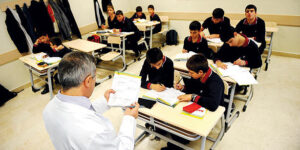
Turkey isgoing to apply the education reform passed by the government in March in the approaching school year, but educators and parents think that the Ministry of Education hasn’t taken adequate measurements to lay the essential groundwork for a smooth transition.
The reform, referred to as 4+4+4 — 4 years of primary, middle and high school — lowers the school beginning age to 60 months plus, from a previous 72 months plus. This is anticipated to stimulate a score of troubles, as the number of children beginning school this year might be double the figure in a normal year. Educators’ unions and parents have highlighted the deficiency of facilities to accommodate the surge in students.
The education reform of the Justice and Development Party (AK Party) has demonstrated controversial. Critics debate that the government is trying to de-secularize Turkey’s education system by letting imam-hatip schools, with their religious course of study, to open middle schools. Previously, Turkish children would have 8 years of primary education abided by high school. The government tells it’s applying the traditional and universally accepted standard of three schools before university. Critics accuse the government of acting out of revenge against the Feb. 28, 1997 military intercession, which saw the closing down of imam-hatip middle schools. Indeed, some schools have complained of being turned into imam-hatip schools against the will of teachers and parents.
The principal of an İstanbul school, who asked not to be named as public officials are not authoritative to talk to the press, told that in a normal school year they’ve enrollments of 220 first graders (30 to 35 students per classroom). “Til now we have 350 affirmed students,” he told, which brings the number of students in the school, which has seven first-year classes, to 50 students. “All the same, that’s not all,” he noted. As the new system allows the optional enrollment of children between 60 and 66 months based on parental permission, 150 applications are pending. “We told families that their children are too young, that they shouldn’t rush, but nobody has changed their mind so far.”
The school is in Esenyurt, a poor zone in İstanbul that is home to a large number of slum settlements, a place where, for most families, sending a child to school is an easy way of holding him or her off the streets. Accordingly, such families are more probable to take the choice of sending their children to school younger.
Indeed, if none of the parents in Esenyurt with children whose ages fall within the optional category for schooling decide to keep their children at home, there might be as many as seventy kids in one classroom. “We’re in a really difficult position. They’ll have to sit 3 or 4 kids in one row,” the principal told. “These children will be the guinea pig generation. Their hand muscles aren’t even developed enough to write. The curriculum is also not very clear yet. What are we supposed to do with these children? Are we going to read them story books?”
There have been reports pointing that in some schools, schoolrooms might contain as many as 80 students.
The Union of Education and Science Laborers (Eğitim Sen) recently brought out a affirmation listing troubles which are probably to rise from the reform. The union noted that first-time enrollments will increase by 75 percent this year, but that no new schoolrooms have been constructed; the first problem to be fronted by schools such as that in Esenyurt.
















 Afrikaans
Afrikaans Shqip
Shqip አማርኛ
አማርኛ العربية
العربية Հայերեն
Հայերեն Azərbaycan dili
Azərbaycan dili Euskara
Euskara Беларуская мова
Беларуская мова বাংলা
বাংলা Bosanski
Bosanski Български
Български Català
Català Cebuano
Cebuano Chichewa
Chichewa 简体中文
简体中文 繁體中文
繁體中文 Corsu
Corsu Hrvatski
Hrvatski Čeština
Čeština Dansk
Dansk Nederlands
Nederlands English
English Esperanto
Esperanto Eesti
Eesti Filipino
Filipino Suomi
Suomi Français
Français Frysk
Frysk Galego
Galego ქართული
ქართული Deutsch
Deutsch Ελληνικά
Ελληνικά ગુજરાતી
ગુજરાતી Kreyol ayisyen
Kreyol ayisyen Harshen Hausa
Harshen Hausa Ōlelo Hawaiʻi
Ōlelo Hawaiʻi עִבְרִית
עִבְרִית हिन्दी
हिन्दी Hmong
Hmong Magyar
Magyar Íslenska
Íslenska Igbo
Igbo Bahasa Indonesia
Bahasa Indonesia Gaeilge
Gaeilge Italiano
Italiano 日本語
日本語 Basa Jawa
Basa Jawa ಕನ್ನಡ
ಕನ್ನಡ Қазақ тілі
Қазақ тілі ភាសាខ្មែរ
ភាសាខ្មែរ 한국어
한국어 كوردی
كوردی Кыргызча
Кыргызча ພາສາລາວ
ພາສາລາວ Latin
Latin Latviešu valoda
Latviešu valoda Lietuvių kalba
Lietuvių kalba Lëtzebuergesch
Lëtzebuergesch Македонски јазик
Македонски јазик Malagasy
Malagasy Bahasa Melayu
Bahasa Melayu മലയാളം
മലയാളം Maltese
Maltese Te Reo Māori
Te Reo Māori मराठी
मराठी Монгол
Монгол ဗမာစာ
ဗမာစာ नेपाली
नेपाली Norsk bokmål
Norsk bokmål پښتو
پښتو فارسی
فارسی Polski
Polski Português
Português ਪੰਜਾਬੀ
ਪੰਜਾਬੀ Română
Română Русский
Русский Samoan
Samoan Gàidhlig
Gàidhlig Српски језик
Српски језик Sesotho
Sesotho Shona
Shona سنڌي
سنڌي සිංහල
සිංහල Slovenčina
Slovenčina Slovenščina
Slovenščina Afsoomaali
Afsoomaali Español
Español Basa Sunda
Basa Sunda Kiswahili
Kiswahili Svenska
Svenska Тоҷикӣ
Тоҷикӣ தமிழ்
தமிழ் తెలుగు
తెలుగు ไทย
ไทย Українська
Українська اردو
اردو O‘zbekcha
O‘zbekcha Tiếng Việt
Tiếng Việt Cymraeg
Cymraeg isiXhosa
isiXhosa יידיש
יידיש Yorùbá
Yorùbá Zulu
Zulu